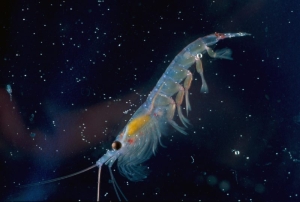Did you know that krill is a vital food source for several species in Antarctica?Krill is a key component of the Antarctic marine ecosystem and the main source of nourishment for several species in the ecosystem.

Antarctic krill (Euphausia superba) are about six cm long, weigh 20 g and can live to the age of seven years. They contain substantial amounts of fat and swim in huge swarms that make them easy and nutritious prey for seabirds, penguins, seals and whales – and also make them attractive to trawlers. Like other crustaceans, krill have an outer shell that must be shed periodically. Between moults, krill can grow if food is plentiful, but if food is scarce, they can shrink. Krill occur in huge swarms and have a patchy distribution in Antarctica; researchers estimate the population to between 50 and 500 million tonnes. Krill swarms can stretch several kilometres in all directions and contain up to 30,000 individuals per cubic meter! Antarctic krill is considered a cold-water species and thrives best at seawater temperatures under 2 °C. In the winter, krill are dependent on sea ice, where they graze on the ice algae that grow on the underside of the ice. For this reason, krill may be acutely vulnerable if seawater temperatures rise and sea ice melts away. Krill fishing in the Southern Ocean is managed by the Commission for the Conservation of Antarctic Marine Living Resources (CCAMLR). Fishing starts in December and ends in August/September, and is concentrated to the area from South Georgia and southwest to the western shore of the Antarctic Peninsula. Since 1992/93 the krill catch has totalled about 100,000 to 130,000 tonnes. Being a rich source of omega-3 fatty acids, these tiny crustaceans are in great demand within the health food industry. |
South Pole 1911–2011 is an informational outreach project run by the Norwegian Polar Institute
Contact person:


